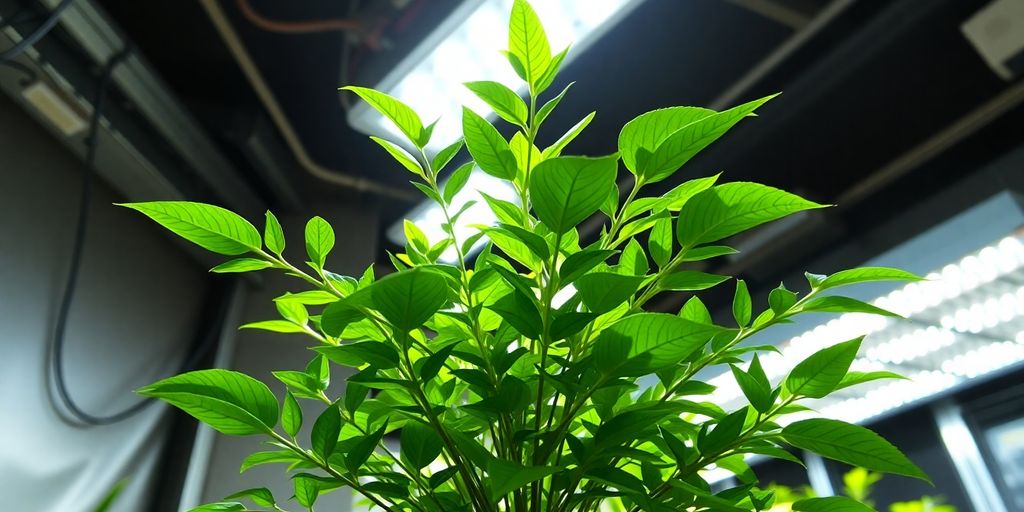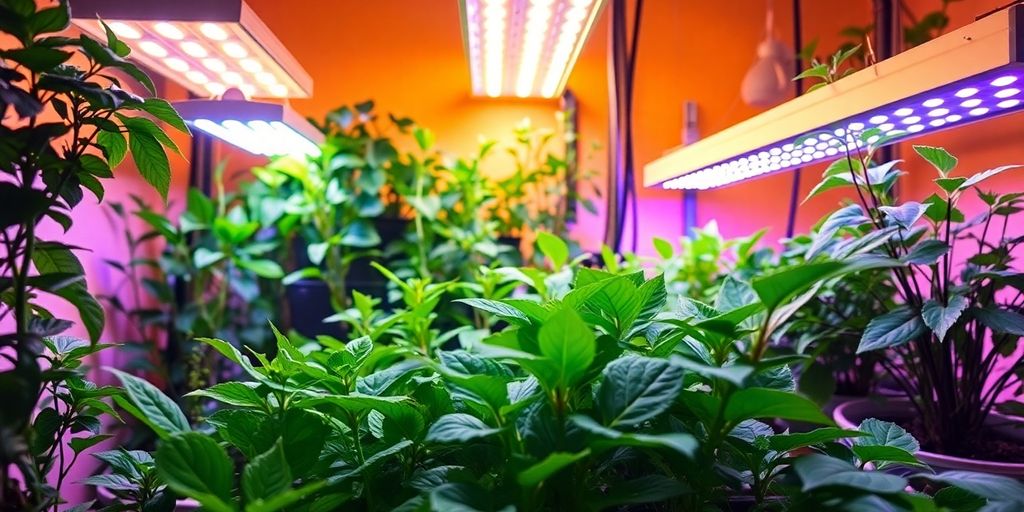When it comes to keeping indoor plants healthy and thriving, lighting is key. Many folks think they can just pop a plant on a windowsill and call it a day, but it’s not that simple. Different plants have different light needs, and sometimes, natural light just doesn’t cut it.
So, if you’re wondering, “What’s the Best Lighting for Indoor Plants?” you’re in the right place. This guide will break down everything you need to know about lighting for your indoor garden, from understanding what your plants need to picking the right grow lights and making the most of them.
- Different plants have unique light needs; know your plants to choose the right light.
- Full spectrum lights are best for mimicking natural sunlight, promoting healthy growth.
- Proper placement and adjusting light duration are crucial for maximizing plant health.
Understanding the light requirements of indoor plants

Okay, so you wanna keep your indoor plants happy, right? Well, it all starts with understanding their light needs. It’s not just about sticking ‘em near a window and hoping for the best. Different plants have different preferences, just like us when it comes to food or music.
I’ve seen it firsthand – give a fern the same light as a cactus, and you’re gonna have one happy cactus and one sad fern. Let’s break it down a bit.
The role of light in photosynthesis
Alright, let’s get a little science-y, but I promise to keep it simple. Photosynthesis is basically how plants eat. They use light to turn water and carbon dioxide into sugar (their food) and oxygen (which we breathe – pretty cool, huh?).
Think of light as the fuel for this process. No light, no food. Not enough light, not enough food. And just like us, if they don’t get enough food, they get weak and don’t grow so well. I remember when I first started with plants, I thought any light was good light. Boy, was I wrong! My poor basil was practically starving until I figured out it needed way more sunshine.
Different light needs for various plant types
Now, here’s where it gets interesting. Not all plants want the same amount of light. Some are like me on a sunny day – they soak it all up and love it. Others are more like vampires, preferring the shade. Generally, we can break it down like this:
- High-light plants: These guys need bright, direct sunlight for at least 6 hours a day. Think succulents, cacti, and some flowering plants. They’re the divas of the plant world.
- Medium-light plants: These plants like bright, indirect light. A spot near an east-facing window is usually perfect. Most common houseplants, like snake plants and ZZ plants, fall into this category.
- Low-light plants: These troopers can handle less light. They’re great for those darker corners of your house. Think cast iron plants and some types of ferns. Don’t get me wrong, they still need some light, but they’re not as demanding.
It’s kinda like Goldilocks and the Three Bears – you gotta find the light that’s just right for your plant. And if you’re not sure, there are a bunch of apps out there that can help you measure the light in your home. They’re not perfect, but they can give you a general idea. Trust me, your plants will thank you for it!
Selecting the right grow light for your indoor garden

Okay, so you’re ready to dive into the world of grow lights? Awesome! Picking the right one can feel like a whole thing, but trust me, it’s worth it. I’ve seen firsthand how the right light can totally transform a sad-looking plant into a thriving green machine. Let’s break it down, step by step.
Types of grow lights available
There’s a whole bunch of different types of grow lights out there, and each has its own pros and cons. It’s kinda like choosing the right tool for a job – you wouldn’t use a hammer to screw in a screw, right? Here’s the lowdown:
- LEDs (Light Emitting Diodes): These are super popular these days, and for good reason. They’re energy-efficient, last a long time, and don’t put out a ton of heat. Plus, you can find LEDs that offer specific light spectrums for different stages of plant growth. I’ve had good luck with LEDs, especially for leafy greens and herbs.
- HID (High-Intensity Discharge) lights: These are the heavy hitters. Think metal halide (MH) for vegetative growth and high-pressure sodium (HPS) for flowering. They give off a lot of light, but also a lot of heat, so you’ll need to think about ventilation. I used these back in the day, but honestly, LEDs have come so far that I don’t really see the need anymore, unless you’re running a huge operation.
- Fluorescent lights: These are your basic T5 or CFL (compact fluorescent lights). They’re cheap to buy, but not the most powerful. Good for starting seedlings or growing low-light plants, but don’t expect them to do miracles. I started with these, and they’re a decent option if you’re just dipping your toes in.
Factors to consider when choosing lights
Alright, so you know the types of lights. Now, how do you actually pick one? Here’s what I always keep in mind:
- Plant type: Different plants need different amounts of light. A cactus isn’t gonna be happy under a dim fluorescent, and a fern will probably get scorched under a super-bright HID. Do your research and figure out what your plants need. Matching the light spectrum to your plant’s growth stage is key for optimal results.
- Grow space size: A tiny little light isn’t gonna cut it for a whole room of plants. Think about the area you need to cover and get a light that’s appropriately sized. You can always use multiple smaller lights if that works better for your setup.
- Budget: Grow lights can range from cheap as chips to seriously expensive. LEDs tend to be pricier upfront, but they save you money in the long run because they use less electricity. Think about your budget and what you’re willing to spend, but don’t necessarily go for the cheapest option – you often get what you pay for.
- Heat: Some lights, like HIDs, put out a lot of heat. If you’re growing in a small space, that can be a problem. LEDs are much cooler, which is a big plus. You might need to invest in ventilation if you go with a hotter light.
- Light Spectrum: Different light colors affect plants differently. Blue light is great for leafy growth, while red light helps with flowering. Some lights let you adjust the spectrum, which is pretty cool. I like having that control, but it’s not essential.
Maximizing light effectiveness for plant growth
Placement and coverage strategies
Alright, so you’ve got your grow lights, now what? It’s not just about sticking them up and hoping for the best. Where you put those lights and how well they cover your plants makes a huge difference. Think of it like trying to get a tan – you gotta position yourself just right to catch those rays, right? Same deal here.
- Distance Matters: The closer the light, the more intense it is. But get too close, and you might burn your plants. Finding that sweet spot is key. I usually start with the manufacturer’s recommendations and then adjust based on how my plants are reacting. If they look stressed or bleached, I move the light further away. If they’re stretching like they’re trying to reach for something, I bring it closer.
- Coverage is King: Make sure all your plants are getting enough light. If you’ve got a bunch crammed together, some might be in the shadows. Rotate them regularly so everyone gets a fair share. I’ve even used reflectors to bounce light around and get into those hard-to-reach spots. It’s like a little suntan reflector for your plants!
- Reflect and Redirect: Speaking of reflectors, they’re your best friend. White walls, reflective film, anything that bounces light back to your plants is going to help. You’re basically getting more bang for your buck by using the light that would otherwise be wasted. I’ve seen folks use emergency blankets as reflectors in a pinch – hey, whatever works!
Adjusting light duration for optimal growth
Light duration, or photoperiod, is how long your plants are exposed to light each day. It’s not a one-size-fits-all thing; different plants need different amounts of light. Getting this right can seriously impact how well your plants grow and even when they flower.
- Know Your Plant’s Needs: Some plants are “long-day” plants, meaning they need 12-14 hours of light to thrive. Others are “short-day” plants and prefer less light. And then there are “day-neutral” plants that don’t really care either way. Do a little research to figure out what your plants need.
- Vegetative vs. Flowering: Plants often need different light durations depending on their growth stage. During the vegetative stage (when they’re just growing leaves and stems), they usually need more light. When it’s time to flower, they might need less. For example, many folks growing tomatoes indoors give them 16-18 hours of light during the vegetative stage and then switch to 12 hours when they want them to start producing fruit.
- Here’s a quick example of how light duration might affect plant growth:
| Plant Type | Vegetative Stage Light Duration | Flowering Stage Light Duration |
|---|---|---|
| Long-Day Plants | 14-18 hours | 12-14 hours |
| Short-Day Plants | 10-12 hours | 14-16 hours |
| Day-Neutral Plants | 12-16 hours | 12-16 hours |
Final Thoughts on Lighting for Indoor Plants
In wrapping things up, finding the right lighting for your indoor plants is key to keeping them healthy and thriving. Remember, not all plants are the same; some need more light than others. So, whether you’re using natural sunlight or grow lights, make sure to match the light type and intensity to your plants’ needs.
Keep an eye on how they respond, and don’t hesitate to adjust your setup if things aren’t going as planned. With a little trial and error, you’ll get the hang of it. Happy gardening!
Frequently Asked Questions
What type of light do indoor plants need?
Indoor plants generally need bright, indirect light. Some plants, like succulents, prefer direct sunlight, while others, like ferns, thrive in low light.
How long should I keep grow lights on?
Most indoor plants do well with about 12 to 16 hours of light each day. However, make sure to give them some dark time too, as they need rest.
Can I use regular light bulbs for my plants?
Regular light bulbs may not provide the right spectrum of light for plant growth. It’s better to use grow lights that are designed specifically for plants.
